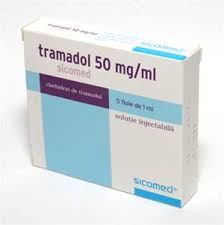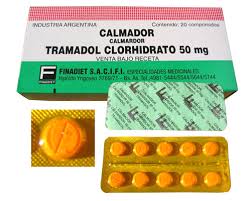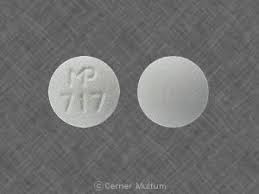Tramadol ®
| Grünenthal GmbH |
 |
| Click here to add coment |
|
Tramadol (Ultram, Tramal is a centrally-acting analgesic, used for treating moderate to moderately severe pain. and, as such, is an UsesTramadol is used similarly to Codeine, to treat moderate to moderately severe pain and most types of neuralgia, including trigeminal neuralgia.[6] Another popular use of Tramadol is as a remedy for opiate/opioid withdrawal, especially since it being uncontrolled has led to many addicts weaning down or altogether stopping their addiction to opiates. Tramadol is somewhat pharmacologically similar to Levorphanol (albeit with much lower μ-agonism), as both opioids are also NMDA-antagonists which also have SNRI activity (other such opioids to do the same are Kratom, Dextropropoxyphene (Darvon) & M1-like molecule Tapentadol (Nucynta, a new synthetic atypical opioid made to mimic the agonistic properties of Tramadol’s metabolite, M1(O-Desmethyltramadol). It has been suggested that Tramadol could be effective for alleviating symptoms of depression, anxiety, and phobias[7] because of its action on the noradrenergic and serotonergic systems, such as its “atypical” opioid activity.[8] However, health professionals have not endorsed its use for these disorders,[9][10] claiming it may be used as a unique treatment (only when other treatments failed), and must be used under the control of a psychiatrist.[11][12] AvailabilityTramadol is usually marketed as the hydrochloride salt (tramadol hydrochloride); the tartrate is seen on rare occasions, and rarely (in the US at least) Tramadol is available for both injectionintravenous and/or intramuscular) and oral administration. It is also available in conjunction with APAP (Paracetamol, Acetaminophen) as Ultracet, a non-generic (and therefore expensive) form of a smaller dose of 37.5 mg Tramadol and 325 mg of APAP. Many patients preferred the generic 50MGs (and the more potent Tramadol Extended Release, which comes in doses of 100-400MG).[14] The solutions suitable for injection are used in Patient-Controlled Analgesia pumps under some circumstances, either as the sole agent or along with another agent such as morphine.
Tramadol has been experimentally used in the form of an ingredient in multi-agent topical gels, creams, and solutions for nerve pain, rectal foam, concentrated retention enema, and a skin plaster (transdermal patch) quite similar to those used with lidocaine. Off-label and investigational uses
VeterinaryTramadol is used to treat post-operative, injury-related, and chronic (e.g., cancer-related) pain in dogs and cats[26] as well as rabbits, coatis, many small mammals including rats and flying squirrels, guinea pigs, ferrets, and raccoons. Tramadol comes in ampoules in addition to the tablets, capsules, powder for reconstitution, and oral syrups and liquids; the fact that its characteristic taste is not very bitter and can be masked in food and diluted in water makes for a number of means of administration. No data that would lead to a definitive determination of the efficacy and safety of tramadol in reptiles or amphibians is available at this time, and, following the pattern of all other drugs, it appears that tramadol can be used to relieve pain in marsupials such as North American opossums, Short-Tailed Opossums, sugar gliders, wallabies, and kangaroos among others. Pregnancy and breastfeedingTramadol is in FDA pregnancy category C; animal studies have shown its use to be dangerous during pregnancy and human studies are lacking. Therefore, the drug should not be taken by women that are pregnant unless “the potential benefits outweigh the risks”.[27] Adverse effects and drug interactions
Main side effects of tramadol. Red color denotes more serious effects, requiring immediate contact with health provider.[30]The most commonly reported adverse drug reactions are nausea, vomiting, memory loss, sweating and constipation. Drowsiness is reported, although it is less of an issue than for non-synthetic opioids. Patients prescribed tramadol for general pain relief along with other agents have reported uncontrollable withdrawal-like nervous tremors if weaning off the medication happens too quickly. Respiratory depression, a common side-effect of most opioids, is not clinically significant in normal doses. By itself, it can decrease the seizure threshold. When combined with SSRIs, tricyclic antidepressants, or in patients with epilepsy, the seizure threshold is further decreased. Seizures have been reported in humans receiving excessive single oral doses (700 mg) or large intravenous doses (300 mg). An Australian study found that of 97 confirmed new-onset seizures, eight were associated with Tramadol, and that in the authors’ First Seizure Clinic, “Tramadol is the most frequently suspected cause of provoked seizures” (Labate 2005)[citation needed]. Seizures caused by tramadol are most often tonic-clonic seizures, more commonly known in the past as grand mal seizures. Also when taken with SSRIs, there is an increased risk of serotonin syndrome, which can be fatal. Fewer than 1% of users have a presumed incident seizure claim after their first tramadol prescription. Risk of seizure claim increases 2- to 6-fold among users adjusted for selected comorbidities and concomitant drugs. Risk of seizure is highest among those aged 25–54 years, those with more than four tramadol prescriptions, and those with a history of alcohol abuse, stroke, or head injury.[31] Dosages of coumadin/warfarin may need to be reduced for anticoagulated patients to avoid bleeding complications. Constipation can be severe especially in the elderly requiring manual evacuation of the bowel.[citation needed] Furthermore, there are suggestions that chronic opioid administration may induce a state of immune tolerance,[32][33][34][35] Some have also stressed the negative effects of opioids on cognitive functioning and personality.[36] CharacteristicsStructurally, tramadol closely resembles a stripped down version of codeine. Both codeine and tramadol share the 3-methyl ether group, and both compounds are metabolised along the same hepatic pathway and mechanism to the stronger opioid, phenol agonist analogs. For codeine, this is morphine, and for tramadol, it is the M1 metabolite, O-desmethyltramadol. The closest chemical relative of tramadol in clinical use is Venlafaxine (Effexor), the SNRI. The two molecules are nearly identical. Both tramadol and Venlafaxine share SNRI properties, while Venlafaxine is devoid of any opioid effects. Comparison with related substancesStructurally, Tapentadol is the closest chemical relative of tramadol in clinical use. Tapentadol is also an opioid, but unlike both tramdol and venlafaxine, tapentadol represents only one stereoisomer (the weaker of the two, in terms of opioid effect). Both tramadol and venlafaxine are racemic mixtures. Structurally, tapentadol also differs from tramadol in being a phenol, and not an ether. Also, both tramadol and venlafaxine incorporate a cyclohexyl moiety, attached directly to the aromatic, whilst tapentadol lacks this feature. In reality, the closest structural chemical entity (to tapentadol) in clinical use, is the OTC active, phenylephrine. Both share a meta phenol, attached to straight chain hydrocarbon. And in both cases, the hydrocarbon terminates in an amine. |


